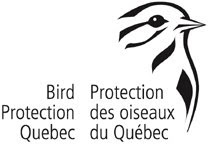St-Basile-le-Grand; Ile-Goyer; and the Chambly Basin in Chambly
18 birders joined us for a morning of interesting birding with weather that no one could complain about given that it's mid-November. A mix of sun and cloud throughout the morning made for good observation conditions, however periods of stiff, cooling wind gave us a little preview of what we can expect in the week(s) ahead!.
It was some time since any of us visited the composting site at St-Basile. The site is no longer operational, having been abandoned for several years now. Nature is gradually reclaiming the site with overgrowth appearing on the majority of the composting mounds. Although quite quiet today, we all agreed that this property, if left undisturbed, could turn into very, very interesting habitat. How likely that is to happen is not sure. A large expanse of land such as this most likely will not remain vacant for ever.
27 species, but it was all about quality. Both target birds today were spotted; one quite easily and the other with the persistence and aid of many top-notch birders present at the Basin today. A large crowd was already gathered as we arrived in Chambly, just in time to see large flocks of Canada Geese arriving from feeding fields at about 10 am. A great display of aerobatics and feeding was put on by numerous Bonaparte's Gulls over the rapids adjacent to Fort Chambly. Upon arriving on 1e rue on the St-Mathias side of the Basin, we met up with 30 to 40 birders lined up along the shoreline having already spotted the Greylag goose. Everyone in our group got very good looks at the bird. It was here that we were told of the location of the Great Cormorant, seen earlier in the morning by many at the end of the pier at the Chambly Marina near the locks bridge. We also learned of a new arrival at the same location that morning, a Fulvous Whistling-Duck!
Upon arriving at the marina parking, the duck was quickly found just offshore sitting with four Double-crested Cormorants, a few Bonaparte's Gulls and a Great Black-backed Gull. The Great Cormorant has been flushed off the pier just a little earlier by a small fishing boat. Many birders continued to arrive at this location over the next hour or so. Several keen eyed birders helped us eventually locate a lone Horned Grebe and finally, the Great Cormorant, perched on a snag quite far out on the Basin in the direction of St-Mathias.
Overall, a very rewarding morning of birding with many of our party adding three lifers to their lists. Here is our complete list for today's outing. Thanks to all who participated and a special thanks to so many of the other excellent birders on scene who helped out with their spotting skills. - Sheldon
Snow Geese 100+, Canada Geese 7000+, American Black Duck 6, Mallard 200+, Lesser Scaup 40, Common Goldeneye 30, Hooded Merganser 50, Common Merganser 200+, Greylag Goose 1, Fulvous Whistling-Duck 1, Horned Grebe 1, Double-crested Cormorant 4, Great Cormorant 1, Great Blue Heron 4, Red-tailed Hawk 2, Bonaparte's Gull 200+, Ring-billed Gull 200+, Herring Gull 1, Great Black-backed Gull 4, Rock Pigeon 10, Belted Kingfisher 1, Blue Jay 2, American Crow 12, Horned Lark 6, European Starling 50, American Tree Sparrow 4, Dark-eyed Junco 2
Oies des neiges 100 +, 7000 + Bernaches du Canada, Canard noir 6, Canard colvert 200 +, Petit Fuligule 40, Garrot à oeil d'Or 30, Harle couronné 50 , Grand Harle 200 +, une oie cendrée, Dendrocygne fauve 1, Grèbe esclavon 1, Cormoran à aigrettes 4, Grand Cormoran 1, Grand Héron 4, Buse à queue rousse 2, Mouette de Bonaparte 200 +, Goéland à bec cerclé 200 +, Goéland argenté 1, Goéland marin 4, Pigeon biset 10, Martin pêcheur d'Amérique 1, 2 Geai bleu, Corneille d'Amérique 12, Alouette hausse-col 6, Étourneau sansonnet 50, Bruant hudsonien 4, Junco ardoisé 2
Subscribe to:
Post Comments (Atom)





No comments:
Post a Comment